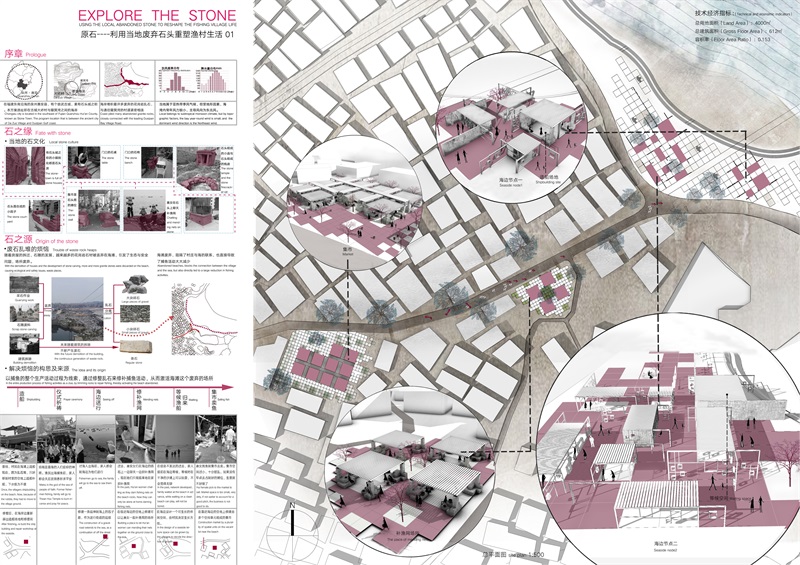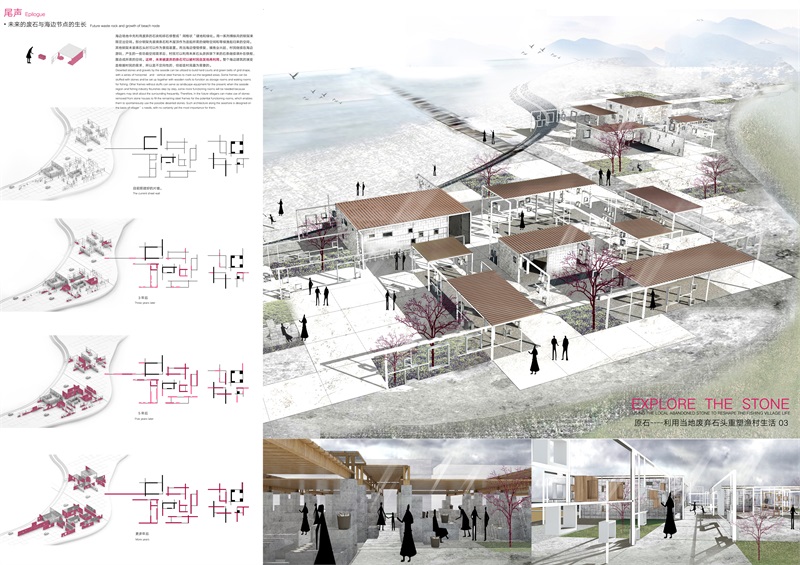


1、 作品项目数据(Project data):
项目名称:中文(Chinese)原石——利用当地废弃石头重塑渔村生活
英文(English):Explore The Stone-- Using the local abandoned stone to reshape the fishing village life
作品所选地点(Location):中国福建省泉州市惠安县崇武镇大岞村
总用地面积(Land Area):4000㎡
总建筑面积(Gross Floor Area):612㎡
容积率(Floor Area Ratio):0.153
2、 项目简介(Project Introduction)
本设计选址为福建东南沿海的泉州崇武大岞村。当地因石头资源丰富素有石头城之称。但也因当地都是石砌建筑,村民将建筑拆除后的石条和开采的一些废石堆放在一个名为“簸箕湾”的海滩上。那一堆废石不仅阻隔了村庄到海的交通,更影响了捕渔生活,导致捕鱼活动渐渐消失。我们此次“建筑资源再利用”就是研究、重利用建筑废石重塑渔村生活。
面对海边一大堆石头,我们在思考为什么要用石头、石头能用于哪里这一系列问题。集市上的石头摊位、天后宫石砌的炮庭、海边小庙石砌的香炉以及每家每户门前的石椅、石桌等都可见村民生活与石头息息相关。这就是“石之缘”。从天后宫到海边的这条小路上,每天都演绎着简单又朴素的生活:清晨目送家人出海、到天后宫祈祷平安、回家或在海滩上修补渔网、挑满筐的鱼到集市卖……如今,渔民生活被破坏,经过分析,需用石头修复的与渔民生活相关的场所有:海边集市、补渔网和造船空间以及海边节点。这是我们构思的来源,加上第一段的废石来源,即“石之源”。
接下来就是怎么将石头更合理更有趣的再利用,即“石之园”部分。我们先将石头分为碎石和石条两大类。碎石用于海边修整场地;而石条因宽、高长度几乎一致,所以我们引入“模数”的想法,分别分析“石条的尺度”与“人体尺度”,组合成座椅、桌子、柱子等基本单元体,再结合各个活动所需的“距离尺度”组合成适合修补集市、补渔网和造船的空间。
除了考虑现有的海滩乱石,我们还考虑今后拆掉的建筑石条的去处。 在海边,我们做了个“可生长”的建筑。海边场地中先利用废弃的石块和碎石修整成“网格状”硬地和绿化。用一系列横纵向的钢架来限定出一系列空间。部分钢架先装填石条和木屋顶作为造船和等候渔船归来的空间,其他未装填石头的钢架先作为景观装置。而当海边慢慢修复,捕渔业兴起,产生一些功能空间需求后,村民可以利用未来石头房拆除下来的石条继续填补在铁框上,围合成所需的空间。这样,未来被废弃的石条可以被村民自发地再利用。整个海边建筑的演变是根据村民的需求,所以是不定向性的,但却是村民最为需要的。
平面设计提取“渔网”元素。用网来织补破碎的渔民生活场所,重用石头来解决渔村的生活及生存问题。在变化有趣的石条模数上,织网、卸货、唠叨家常。在这一路上,模糊的记忆慢慢被织补、渔民生活慢慢交流融合。
This design selects the Dazuo village Chongwu county Quan zhou city in Fujian's south-east coastal area. The region earns the title "the stone city" for its affluent stone resources.since the stone is the main architectural materials in this region, there are piles of stone strips and stones after the buildings were abandoned. Local villagers heaped them up in a seabeach near the "Boji Bay". The pile of abandoned stones not only block up the traffic from the village to the sea, but also h**e a big influence in local fishing, which is fading away. In conclusion, our program "Reuse the architectural resources" aims to study and reuse the abandoned architectural stones to rebuild the life in this fishing village.
When we saw so many stones on the beach,we wondered a series questions ,like why we would use stones , what stones could be used. The stone stalls in the bazaar , the stone-structured gun chamber in Tianhou temple,the stone-structured censer in a small temple beside the sea , and household such as stone benches ,stone tables , all of these proved that villagers’ lives are related with stones.It is what we called “Fate with stone”.On this path from the Tianhou temple to the beach , deducing the simple and plain life: every morning villagers watched their families out to sea, went to the temple to pray peace, mended their nets at home or on the beach,sold full basket of fish in the market ... Nowadays,fishmen’s lives were destoryed,if we want to repaire fishmen’s lives by stones,serval sites need to be considered : the bazzars, the place they mended nets and maked ships , and the nodes by the sea. In conclusion , these are where our thoughts come from,coupled with the source of wasted stones in first paragraph , it was what we called “origin of the stones”.
The next is how to more reasonable and more interesting use of the stone, that is, "stone garden" section. We first divided the stone into two categories: gr**el and stone. Gr**el used to trim the beach site; For width and height of the stone almost unanimously. So we put porward the idea of "module" . Analysis, respectively, the scale of the "stone" and "human scale" ,and combined into The basic unit such as chairs, tables, columns, etc.Then combined with the "disance scale" which various activities needed , making these space where thay can repair bazzars,mend nets and make ship.
In addition to considering the existing rocky beach, we also consider the stones removed from stone houses in the future. In the seaside, we made a ‘‘growing building’’ .Deserted stones and gr**els by the seaside can be utilized to build hard courts and green belts of grid shape, with a series of horizontal and vertical steel frames to mark out the targeted areas. Some frames can be stuffed with stones and be set up together with wooden roofs to function as storage rooms and waiting rooms for fishing. Other frames without stuffs can serve as landscape equipment for the present; when the seaside region and fishing industry flourishes step by step, some more functioning rooms will be needed because villagers may stroll about the surrounding frequently. Therefore, in the future villagers can make use of stones removed from stone houses to fill the remaining steel frames for the potential functioning rooms, which enables them to spontaneously use the possible deserted stones.
Three node plan pull out the eletment from “fishing nets”.Use net To darn fishermen’s broken living places, and reuse of stone to solve the problem of life and survival of the fishing village .People netting, unloading, homely chatter in these interesting stones. Along the way, Vague memories were slowly
darn, fishmen's lives were slowly merged together.
大图链接:
51原石——利用当地废弃石头重塑渔村生活1.jpg
51原石——利用当地废弃石头重塑渔村生活2.jpg
51原石——利用当地废弃石头重塑渔村生活3.jpg